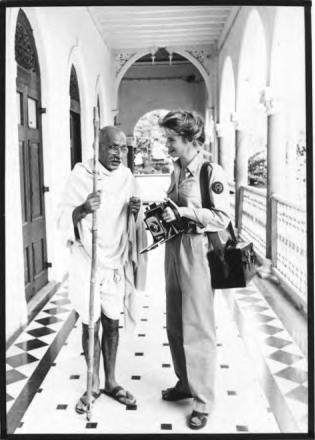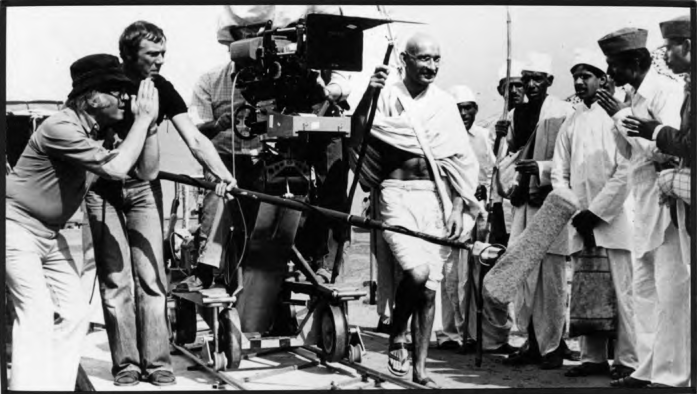GANDHI
A Film By Sir Richard Attenborough
Featuring
Ben Kingsley
Candice Bergen
Martin Sheen
Trevor Howard
John Mills
Sir John Gielgud
A Brief Cine-Survey By J.S. Christensen
Also
GANDHI'S HUMOR


GANDHI
A Film By Sir Richard Attenborough
MOHANDAS KARAMCHAND GANDHI was born October 2, 1869 at Porbandar in the state of Gujarat, India. During the second half of his life he became his country’s most famous political and spiritual leader. The respectful title of Mahatma meaning “great soul” was bestowed upon him by hundreds of millions of followers. Felled by an assassin in 1948, Gandhi is now regarded throughout the world as the founder of the international movement toward nonviolence.
At present the best and most popular introduction to the fascinating life and accomplishments of Mahatma Gandhi is the celebrated motion picture Gandhi created by Sir Richard Attenborough. Outstanding for biographical, historical and artistic merit, this film depicts Gandhi’s mature years only, dramatizing the most significant events during his public career and private life, from the time he was an obscure young lawyer and unknown activist for human rights, until he attained his full stature as history’s foremost advocate of massive Civil Disobedience, and later as an enormously influential elder statesman.
Attenborough’s three hour and eight minute movie about Mahatma Gandhi’s adulthood was twenty years in the making —— filmed with epic proportions across the vast nation of India. Its premiere showing was presented in New Delhi on the last day of November, 1982, soon followed by openings in London, New York and Los Angeles.
The $22-million production received an enthusiastic reception, from critics and audiences alike, who unanimously proclaimed Gandhi as one of those rare events in film history — an instantaneous classic. Since then it continued to gross over $100-million. Such commercial success is astonishing in view of the fact that this motion picture also ranks as the most complex theatrical movie ever produced — logistically and politically and financially. Gandhi won eight Hollywood Oscars at the 1983 American Academy Awards, establishing the record for the most Oscars ever earned by a British film.
It was no surprise when top honors for Best Film and Best Director in both the United Kingdom and America went to Sir Richard Attenborough. Long before this extraordinary production, he already had proved himself consummate master of the dramatic arts —— as an accomplished actor, director and producer —— with an international film and stage career. In 1976 Attenborough was knighted by Queen Elizabeth II. After his leading role in the mega-hit movie Jurassic Park in the early 1990s his professional history attained fifty years.
To prepare for his film about Mahatma Gandhi, Attenborough studied Gandhi’s writings and speeches and all the biographies in English. He considered the best biography at the time to be The Life Of Mahatma Gandhi by American author Louis Fisher who visited Gandhi in residence at his Sevagram Ashram near the city of Wardha in Central India. Attenborough commissioned the writing of a dozen progressive versions of the screenplay during an extended development of an essentially dramatic treatment of history.
After many years of setbacks, his determination to complete a Gandhi movie became an obsession, while the project earned him a mounting ridicule within the film industry, but his dream finally came true.
Ben Kingsley received the 1983 Best Actor Oscar for his flawless performance in the leading role. This distinguished Shakespearean player is himself half Indian by birth, and his physical resemblance to Gandhi was so remarkable that it caused delays in filming while the company was working on location in public places where spectators approached Kingsley to lay flowers at his feet. For historic accuracy certain scenes were shot in areas where millions of people regard Gandhi not only as a national hero but also as a beloved father figure.
Other exceptionally fine actors were cast in supporting roles, including Martin Sheen, Sir John Gielgud, Trevor Howard, John Mills and Candice Bergen who agreed to play her part fifteen years before the filming of her scenes actually started. While most of the picture was photographed throughout India, all the sequences featuring Sir John Gielgud were shot in England.
The 1983 Hollywood Academy Award for Best Screenplay went to John Briley for his final shooting script. According to Attenborough, “This brilliant writing is imbued with drama and emotion and humor and pain. At every moment it main- tains a driving story line which permits the movie to span more than half a century in just over three hours of screen time.” Attenborough regarded it as the best filmscript he had ever read during thirty years of moviemaking. Fewer than a dozen words of dialogue were changed while shooting. Attenborough also said that John Briley’s perception of Gandhi —- as one of the most significant and fondly respected personages of the Twentieth Century — greatly impressed many highly qualified scholars on the subject, this accomplished within the context of pure entertainment. Briley managed to convey the essential truth of Gandhi’s nonsectarian teachings about basic human rights and the need for an international movement toward universal nonviolence, a trend which Gandhi advocated to the end of his long career — a lifetime filled with action and conflict and tragedy and joy.
Oscars also were bestowed upon Gandhi for excellence in the highly coveted categories of Best Cinematography, Best Editing, Best Art Direction and Best Costumes — all these professional achievements indicating why Gandhi is such a beautiful movie to see and enjoy again and again. Here are a few comments from published reviews:
Variety: “Once in a long while a motion picture so eloquently expressive and technically exquisite comes along that one is tempted to hail it as being near perfect. Such a film is Gandhi.”
Newsday: “An outstanding example of traditional excellence in film crafting and performance.”
Christian Science Monitor: “It’s an epic worthy of the name, rooted in some of the most fascinating historical events of our century.”
Roger Ebert: “This is the sort of rare epic film that spans the decades, that uses the proverbial cast of thousands, and yet follows a human thread from beginning to end.”
New York Post: “Gandhi is the kind of massive accomplishment for which ordinary adjectives like ‘brilliant’ or ‘sweeping’ or ‘magnificent’ seem anemic and inadequate. Attenborough’s film examines the ideals, hopes, dreams and disappointments of this legendary guru while providing a rich tapestry of India. But the real, devastating miracle of Gandhi is the overwhelming performance by Ben Kingsley in the title role. A young member of England’s Royal Shakespeare Company — who is in his late thirties and half Indian through his paternal ancestry and comes from the same village where Gandhi was born — Kingsley seems so real, so natural that he brings an unshakable moral force to the screen.”
Time: “It is impossible to recall an actor who has aged more persuasively over the course of a movie.”
Los Angeles Times: “Immediately we are carried into one of the film’s most amazing mass scenes, the funeral cortege in Delhi.”
The undertaking of this truly monumental film sequence that recreated the funeral of Mahatma Gandhi involved the greatest number of people ever assembled in the production of a theatrical movie. The scene includes the largest group of extras employed on any film, with persons paid by contract totaling 94,560. In addition the production company appealed to the general public to come and participate as mourners. The call was answered by approximately 200,000 unpaid volunteers who congregated with the professional extras to form a crowd that police estimated to be “somewhere between a quarter of a million and 350,000.”
Supplemental camera crews were flown in from England to provide eleven separate photographic angles of the funeral march. The entire scene was filmed on Saturday, January 31, 1981 which was thirty-three years to the day from the actual historic event at the same place in 1948. Wardrobe and make-up people began working at two o’clock in the morning because the filming had to be completed by noon which was the maximum amount of time city officials permitted police to close off main streets.
The central cortege itself was comprised of 1,060 key people. Those portraying main characters of the story walked in a slow march surrounded by some 9,000 professional extras who were carefully selected and arranged as “front liners.” A marching Guard Of Honor was formed by 3,000 members of the nation’s Home Guard, together with 500 representatives of The Gandhi Peace Movement.
The combined camera crews shot 20,000 feet of film, more footage than the total length of the finished movie’s 188-minute released print. And yet the edited funeral sequence runs for only 125 seconds of screen time. Altogether, the production of Gandhi required the exposure of over half a million feet of film stock — exactly 525,150 feet or just under 100 miles.
In 1983 at New Delhi, Sir Richard Attenborough received the Padma Bhusan, awarded annually by The Government Of India for outstanding service to that nation by an individual. He also has written two interesting books entitled In Search Of Gandhi and The Words Of Gandhi.
This cine-survey was compiled by J.S. Christensen in 1991 with a few insertions by Lord Attenborough during 1992.
GANDHI’S HUMOR
WHEN HE DISEMBARKED from a steamer at Marseilles as a world famous personage, Mahatma Gandhi still was required to make a declaration of his possessions to the French customs officer. So he stated, “I am a poor mendicant. My earthly property at this moment consists of six spinning wheels, some dishes, a can of goat’s milk, six homespun loin cloths and towels, and my reputation — which cannot be worth much.”
Once when Gandhi was traveling by train, a lawyer sharing the same compartment fell from his bed to the floor. Luckily he was not injured except for bruises. Later the lawyer claimed that serious injury was averted because his fellow passenger was Mahatma Gandhi who quipped, "Then you shouldn't have fallen out of bed in the first place."
Having been invited to Buckingham Palace to meet England's King George V and Queen Mary, Gandhi arrived for the occasion dressed in his white loincloth, but he immediately put the royals at ease with his naturalness. Afterward someone asked Gandhi if he had been properly attired for the occasion, and he replied, "Oh, His Highness had on enough for both of us."
Gandhi gave everything away following a vow of poverty. But he still had expenses which other persons paid so he could do his work free of financial concerns. He once told an interviewer, "I have many friends who complain to one another about how much it costs them to keep me living in poverty."
A spokesman for a publication once handed Gandhi a few typed sheets, asking him to read the contents carefully and give his opinion. Gandhi glanced at the pages, then removed a paper clip which had held them together. Returning the papers, Gandhi said, "I have extracted the most valuable part of it."
A doctor insisted on giving Gandhi a penicillin injection when he was ill, but the patient refused. The doctor said, "If I give you the shot, you'll recover in three days —— otherwise it could take three months." To which Gandhi replied, "That's all right with me, I'm in no hurry." The doctor protested, "But you might infect others." Gandhi retorted, "Then give them the penicillin."
After Gandhi's devoted wife died, he sat alongside the burning pyre during her cremation, where he remained from early morning without food. Toward evening someone suggested that he retire for some rest and a little nourishment. But he smiled and said, "Surely after sixty-two years of companionship, if I went away from her now, with the cremation unfinished, she would never forgive me."